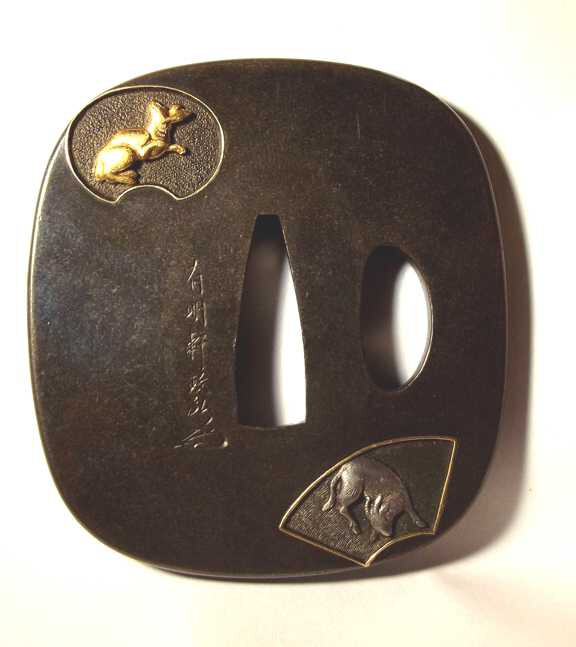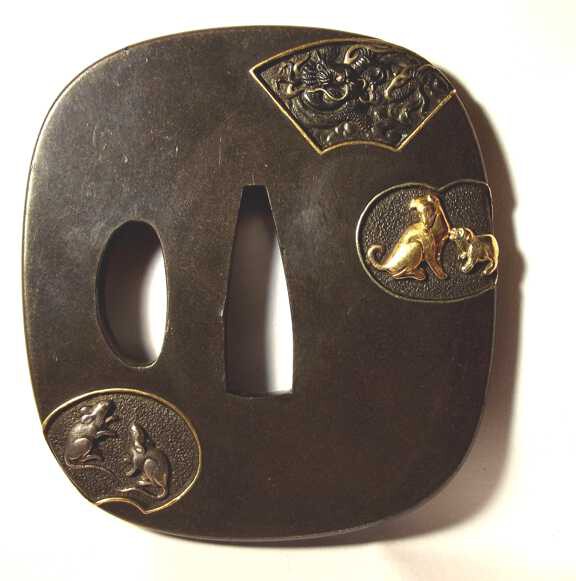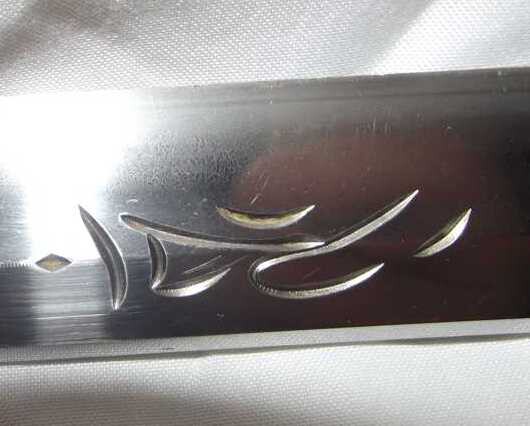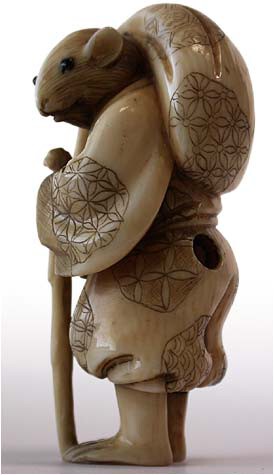-
Posts
435 -
Joined
-
Last visited
Content Type
Profiles
Forums
Events
Store
Downloads
Gallery
Everything posted by Lance
-
I'd go along with everybody else and wouldn't change/replace anything. It seems you have 2 complete period original koshirae, removing original parts from either and replacing them with reproduction pieces would do a great disservice to both swords' history, not to mention greatly devaluing them. Maybe a better option would be to have a new saya made for the wakizashi with horn to match the katana. Regards, Lance
-
If you were looking for a small book that you could bring with you to use as a reference at an arns fair or flea market to help in identifying a blade a good choice would be "Japanese Sword Blades by Alfred Dobree." It's relatively small, has diagrams of different blade, hamon, bohi types, and what schools and smiths they are associated with, also has kanji tables for commonly used smith and province names, sort of a light version of Kokan Nagayama's Connoisseur's Guide to Japanese Swords with an extra section for translating mei and date. It's relatively inexpensive, I think under $50, maybe one of the members here who sells books have a copy or 2 for sale? Regards, Lance
-
Here's some pictures of a tanto tsuba with zodiac animals on a shibuichi base signed Yumyoken Masahiro that I posted in the past, one pic includes a dime for scale. Regards, Lance
-
I don't know of any way to prove it but the tsuba might fit with the rest of the mounts if worn by Kabukimono http://wiki.samurai-archives.com/index. ... Kabukimono or the their spiritual successors, the late Edo town-samurai troublemakers/gangs who's name escapes me but are sometimes seen as an early part of the yakuza.. Anyway it's a pretty attractive/interesting set of koshirae. Sometimes these flashy yet at the same workmanlike koshirae gets me wondering if the wearers would wear these when out looking for trouble, when catching someone's eye they could say "what are you lookin'at?" Regards, Lance,
-
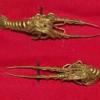
Help with identification of WWII Samauri Sword
Lance replied to cnymike's topic in Military Swords of Japan
The marks that look like they're painted on are assembly numbers, usually put on when the sword was being mounted to keep track of what fittings went with a specific sword as they produced dozens/hundreds at a time. (If it's as bent as the pictures look it might have been run over by something in the field, saw a bent up sword once with what looked to be tread marks on the scabbard) Regards, Lance -
I don't think the koshirae would qualify as Ezo, looks like a variation of late Edo-Meiji brass or silver mounts said to be made for export. From a couple swords I had in the past in these types of mounts they appeared to be made up of different panels molded/carved and held onto the saya and tsuka by metal bands, maybe gliued onto the saya as well? Bob Benson's Bushido newsletters put ot some years ago had some articles about the history of Ezo fittings, I think they originated during Nambokucho, and almost looked like some of the metal trim found on old armors Below is a link from an old discussion: http://www.nihontomessageboard.com/nmb/ ... 0&start=15 Attache a picture of a tsuka from an old Muromachi period Ezo tachi, turns out it came from an online image gallery belonging to Ford https://plus.google.com/photos/10292032 ... 0461207557 Then again here's another sword from a Japanese dealer calling similar mounts Ezo, maybe the term has a broader usage and can be used to refer to large plate metalwork? http://www.sanmei.com/contents/media/O25716_T5940_E.htm Regads. Lance edited for spelling
-
The first 2 characters look to read Yakumo, part of the smith's name that I could make out looks to be Masa. This reminded me of a smith listed in John Slough's oshigata book (page 101) who also used Yakumo (Shimane) in his signature, named Amatsu Masakiyo. It says he became the head swordsmith for the Izumo Seiko Works company in 1942 and also was a Rikugun Jumei Tosho. Between the use of Masa and Yakumo, filework on the tang and overall style of signature being so close I'm guessing your sword was made by another smith or pupil from the same workshop ? Below is a picture for comparison and what I was able to make out character-wise, I'm sure someone will be along to fill in the blanks and/or correct my mistakes. Hope this useful, Lance
-
Sorry Chris, my mistake. Regards, Lance
-
I don't believe it's Imai Kaneitsugu either, but my thinking was the workmanship looks good enough (to me) that he might have been of some note instead of one of the many anonymous Seki smiths. Below are some images of the (cheesey ) horimono, I do think it's step or two up from what's usually found swords from this period, but obviously nothing like the level of some of the examples listed in this topic: http://www.nihontomessageboard.com/nmb/ ... 88&start=0 or this http://www.sabakusamurai.com/sale/consi ... orSale.htm Certainly better than this one though (also last pic posted) http://www.antique-swords.eu/ww2-japane ... imono.html Regards, Lance
-
Thanks guys, I was toying with the idea if the first character being Kane, but it was missing the 4 strokes on the bottom I usually associate with ths kanji and (too quickly) disregarded it. I wish I could have captured better images of the hamon, aside from the nie there's all kinds of other activity running through and above the hamon. P.S. Would I be correct in assuming it's not Imai Kanestsugu (John Slough's Oshigata book page 71) since the kanji used are so different? Extremely grateful for any pointers in the right direction. Thanks again, Lance
-
Hello all, I recently picked up sword in worn gunto mounts, dragon and bonji horimono and a well finished nakago, but the signature's got me stumped. After staying up late trying to figure it out the only thing I was able to come up with is maybe the last character is tsugu? pics below of the tang as well as a couple of the rest of the blade, thanks in advance for your time Regards, Lance
-
If it doesn't break your budget I'd recommend getting the Compton Collection as well. The other books are full of great information, and with the Compton book's excellent large format photography and descriptions it's probably one of the better ways to help recognize the varying schools/types of workmanship described in the other books (aside from handling the real thing of course!) Regards, Lance
-
I'd suggest leaving the finish on the scabbard and handle in its current state. Any NCO sword that's refinished is going to lose it's history and or value - or maybe even mistaken for a newer Chinese reproduction. NCO swords seem to have more in common with military swords from other countries than they do to Nihonto or officer's I gunto, most of them lose value if any restoration is done, similar to when someone polishes the brass handguard on a cavalry saber. Regard Lance
-
Your age estimate looks correct, design looks like shows Hotei and a mouse, both symbols of luck and prosperity, with a little bit of humor thrown in, Hotei is sometimes depicted with Jewels laid out or in his bag, and the mouse is leaving his own little "Jewels" ? :lol: http://art.thewalters.org/detail/35445/ ... ith-hotei/ http://www.buddhamuseum.com/traveller-mouse_13.htm Regards, Lance
-

Update: Index of Japanese Swordsmiths
Lance replied to Markus's topic in General Nihonto Related Discussion
I haven't seen the poll yet, but I'd place an order for this edition of books as well. The higher quality print and hardcover as discussed sounds great, but if this doesn't go through I'll end up buying the other set evenyually. I have a couple of Markus' books, and enjoy them very much, (Legends and Stories around the Japanese Sword was one of a group of books that helped me get through the power outages due to Hurricane Sandy) Thanks to Adrian too, I hope this project is successful. Regards, Lance -
My condolences go out to his family members and friends as well. Many years ago I used to work at a small graphics arts company doing color separations and making negative plates for comics. One of these was working on was a reissue of the English Lone Wolf and Cub manga series. Aside from the enjoyment of being able to read these while working, It was one of a small number of catalysts that occurred around the same time that led me to becoming interested in Nihonto and Japanese art in general, I still have a soft spot for Ogami Itto and his son, and even though I didn't know him I'm still grateful for the impact such a small connection's had on me . Lance
-
Hello Jean, I'm not sure what you mean about the nakago? My suggesting a muromachi period utushi was partly due to the Gassan Sadayoshi attribution which would make it Shin-Shinto; From my (limited) experience if swords from this era were done in a Shinto stlyle they were usually modeled after Sukehiro or Osaka Shinto with yakidashi? The revival pieces were said to be trying to recreate swords making techniques of the koto period, to me the combination of Sugata, Hamon, and nakago looked more like it was intended to copy Koto/Muromachi Bizen. I appreciate the information about bohi ending in kakudome, I've seen these before but never quite put it together as a useful kantei tool. Regards, Lance.
-
In the image below I circled what looks to be the exit for the mekugi peeking out. It seems like when this was put together they offset the kozuka slightly on either side of the tsuka treating them as if they were giant menuki? Regards, Lance
-
Even if it might not fit the usual notion of good taste, from the pictures provided all the components look to be of very good quality, and the assembly/lacquer work looks to be well done too. Maybe one of those late Edo-Meiji export pieces, for some of the wealthy Westerners who bought and commisioned work from artists of that time? (I always figured some of these were for the domestic market too though, similar to earlier "merchant class" koshirae) The blade looks like a good copy of a Muromachi period Bizen wakizashi? Regards, Lance
-
Condition-wise I agree everything Keith wrote, but I don't think it's a fake. At least in the sense that it was made in Japan originally with a gimei signature (mei looks like it was cut by someone familiar with a chisel, just not Yoshimichi) that's been damaged/altered beyond repair. killing the blade.........the murder weapon being...........the grinder in the library! (anyone remember the board game Clue?) Regards, Lance
-
Having the mekugi ana cut into the mei isn't that uncommon, I believe this can also be used sometimes as a way to help judge signatures of certain smiths that would usually place the mekugi ana into a certain spot in their signature. I've noticed this when researching some swords in the past, below is an article/example that touches on this somewhat from the NMB Archive: http://www.nihontomessageboard.com/mei_exercise.html and a sword from Nihonto.com with the ana going through the mei as well. (this example does have 2 ana but both go thru the signature , I think the lower one is the original) http://www.nihonto.com/12.1.09.html Regards, Lance
-
Not saying the signature's good but the placement of the mei at the end of the tang, along with the short stubby shape fit fairly well with an original Muromachi period Bizen tang. The hamachi Looks like it was moved up (machi-okuri) and helps explain the currently short blade length as well. I added a picture using my great photo editing skills for comparison of where the habaki might have originally been, putting the blade somewhere around 16-17 inches, seems a reasonable length for a wakizashi of this time period. Regards, Lance


